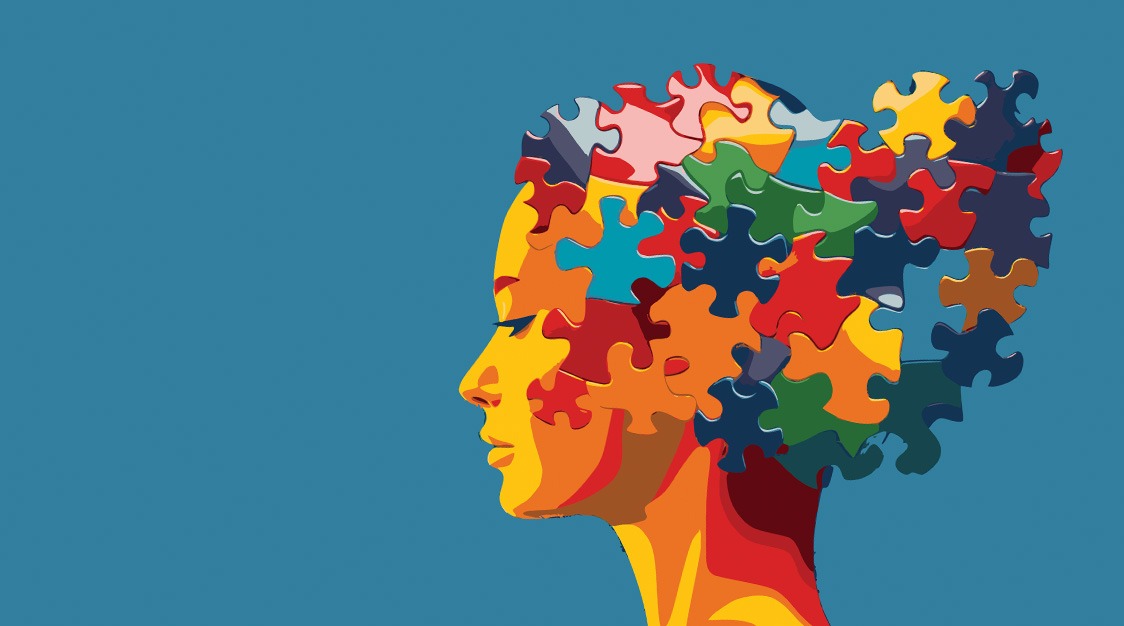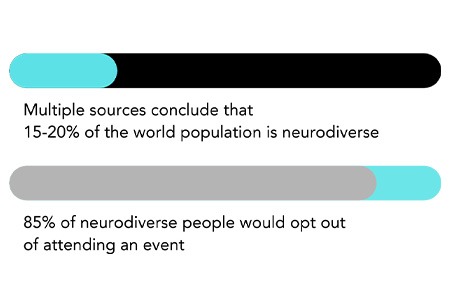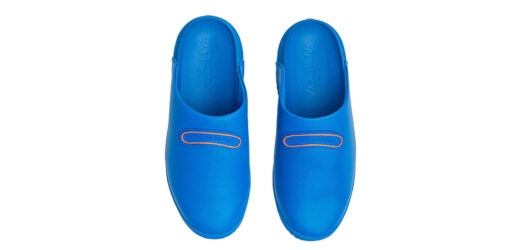Designing accessible events for neurodiverse attendees
Accessibility is an integral part of event design today, and that includes accessibility for neurodiversity. By accommodating all the different ways people’s brains process information, planners can significantly improve the experiences of all attendees and make the world of events a better place. To do so, there are some significant, but simple, changes that go a long way.
In Smart Meeting’s ongoing journey to inspire meeting professionals with the latest tips for elevating the event design process, we worked with the AI app InVideo to bring our content to visual life and allow all viewers to accessibly enjoy content in video form. We hope you enjoy. Please consider following our YouTube channel for more weekly tips and trends for meeting planners.
Neuroinclusion
The term neurodiversity signals that there is no normal way for the human brain to function, and that differences and disabilities in cognition are not necessarily pathological, but simply a difference from what we assume, as a society, is typical. Well-known types of neurodivergence include ASD (autism spectrum disorder), ADHD and dyslexia.
Neuroinclusion goes a step further by implementing the understanding that neurodiversity will always exist in an audience into event design.
“If we lead with [neuroinclusion], everything else follows,” says Megan Henshall, global event solutions, strategic lead at Google and founder and co-lead of the Google Experience Institute (Xi). She is the mother of a child with autism and has pioneered what neuroinclusive events can be. “It honors people’s full personhood, their identities, their strengths, but also their challenges and their disabilities. It’s every dimension of humanity.”
Understanding the Scope
EventWell, a nonprofit social enterprise that educates and campaigns about well-being and neuroinclusion in events, conducted a survey of neurodiverse individuals which found that 85% of respondents have opted out of attending an event because they were concerned that they might get triggered, overwhelmed, overstimulated or simply have a difficult time.
“As event designers, we have to acknowledge that by not being thoughtful about the full personhood of attendees, we can do real harm. Events should restore, regulate and renew; and there is so much we can do to enable that.”
— Megan Henshall, Google Experience Institute (Xi)
Around 20-25% of the world population is neurodivergent—Henshall says, “And I think that’s a very conservative estimate, because diagnosis is a privilege. If you look at that, nearly a quarter of the global population is neurodivergent. And if 85% of those people may not want to go to an event, think about your attrition!”
She explains that events and travel can pose some of the most difficult situations for neurodiverse people. Both often include bright lights and loud, sudden noises; people have little control over their environment, and it’s likely to encounter unpredictable situations. All of these things can be challenging or even triggering.
Education and Training

To offer neurodiverse attendees the accommodations that would make their experience more accessible and enjoyable, it is vital that the people and organizations hosting events have the education and training needed to properly serve this population.
The International Board of Credentialing and Continuing Education Standards (IBCCES) offers certification programs made up of specialized training, practical application and the perspectives of autistic individuals. Organizations and destinations can earn the Certified Autism Center (CAC) and Autism Certificate (AC) accreditations. To find these places, turn to Autism Travel: a free, online resource created by IBCCES that offers a directory of cities, destinations, facilities and organizations with Autism certifications.
Visit Mesa recently became the first Autism Certified City in the U.S.—to do so, at least 80% of guest-facing staff must complete training and certification. In Mesa, over 60 businesses and 5,000 individuals became certified.
“[IBCCES’s] key insights, paired with their Autism Travel nationwide presence, helped our team and our partners better understand the ASD community,” says Alison Brooks, vice president, destination experience and advocacy at Visit Mesa. Mesa offers more accessibility programs as well, such as Aira, a guided visual interpretation service, and is partnered with Wheel the World, an online marketplace that customizes travel recommendations for people with disabilities.
How Events Can Do Better

When it comes to the event, Henshall explains that many of the features planners can implement that would make events more neuroinclusive are little- to no-cost—but they have major ROI in terms of attendee satisfaction.
Let the Attendees Tell You
Pre-event, ask attendees about any accommodations needed for neurodiversity in registration forms, in the same places you ask about ADA accommodations. “Make sure that you speak explicitly to those needs,” says Henshall. “Acknowledge that people are showing up as full human beings with lives outside of your event, and that if they need to step away or stand or take a break, they’re entitled to do that.”
The specific accommodations your attendees ask for are one of the best places to start when you want to know which accommodations to implement. When we look at the general changes that planners can make, there are a few simple things that can improve the experience for everyone.
Re-Imagine How Events are Run
 Accommodation can be as simple as modifying how an event is scheduled. Tight schedules can often leave attendees with little time to rest and regroup, and this makes their experience of the event more exhausting than enriching.
Accommodation can be as simple as modifying how an event is scheduled. Tight schedules can often leave attendees with little time to rest and regroup, and this makes their experience of the event more exhausting than enriching.
“Some of the most impactful things are our flexibility,” says Henshall. “Let people be who they are and navigate the environment in ways that make sense for them.”
Working more choice into the schedule, like giving attendees the option to attend an education session of their choosing or to take a break instead of attending a session, can provide a meaningful feeling of control.
Bright colors, flashing lights and loud, sudden noises can all be sources of potential triggers or overstimulation. Stick to a more calming color palette in the event design and avoid any audio that changes volume rapidly and, in general, avoid extremely loud volumes. This can be more difficult in situations like trade shows, but in these cases, it’s always best practice to brief exhibitors on these guidelines and provide some background information on why it’s important to follow them.
Be Prepared
Often, situations that can trigger or overwhelm attendees aren’t in the planner’s control, especially when the event is running in real time. Be prepared for these scenarios ahead of time by offering “resilient spaces.”
A resilient space could be an unplug lounge, where attendees can go to get away from their phone or computer and rest their minds; or it could be a designated quiet lounge, with comfortable seating and calming colors that attendees can visit in times of mental distress, overstimulation or even if they’re just in need of a break. And when there is more flexibility in event schedules, attendees have a better opportunity to take advantage of these spaces.
“Any little thing you do is not just creating a better experience for your neurodivergent attendees. The ripple effects of it are good for everyone,” says Henshall. At events, she has seen neurotypical people using the designated quiet rooms as well. “People don’t always know what they need,” she explains. “It’s about proactively anticipating people’s needs, especially people who have a disability or are neurodiverse. It’s helpful to everyone, and it is really such a loving kind of thing to do.”
The Impact
Recently, Henshall’s team reached out to Google employees who had previously declined to attend events, stating that doing so would be difficult or uncomfortable for them. Her team invited them to attend an Xi Days event that included many of the accommodations explained above, telling these attendees, “You are the people we want to do better on behalf of, so come and tell us where those opportunities are, and let us know how these things we’ve implemented work for you.”
Afterwards, Henshall says, many of those attendees expressed that they felt a sense of belonging; that they felt seen. “I never imagined that someone would proactively do for me the things I’ve had to do for myself my whole life,” one reported back. “I will come to an event as long as I know that these things are in place.”
The Neu Project
 The Google Experience Institute (Xi) launched in 2021 to research emergent trends and cultural happenings in the events industry and to identify and test best practices for events.
The Google Experience Institute (Xi) launched in 2021 to research emergent trends and cultural happenings in the events industry and to identify and test best practices for events.
Soon after its launch, Henshall explains, “The earliest research showed that we had been designing people out of things for a very long time. We weren’t taking cognitive functioning into consideration; we weren’t thinking in any meaningful way about differences in sensory processing.” The team behind this research began leaning into neuroinclusion.
From this idea, The Neu Project was born. A subdivision of Xi, The Neu Project focuses on amplifying voices within the neurodiverse community and provides planners with practical strategies to create neuroinclusive events.
A Go-To Resource
On its website, planners can access “An Event Professional’s Guide to Neuroinclusion,” a handbook intended to serve as a comprehensive resource for planners aiming to make their events more inclusive. It explores the topic of neurodiversity, the significance of creating inclusive events for all neurotypes and practical strategies for doing so.
Once planners who have read the guide set out to organize their next neuroinclusive event, they can use “The Neuroinclusive Event Checklist.” The checklist is separated into the categories of pre-, during and post-event, and covers everything that a planner considers when organizing an event. Each category includes specific, practical suggestions on how planners can improve neuroinclusion in their events.
This article appears in the January/February 2024 issue as “Events for Everyone.” You can subscribe to the magazine here.






